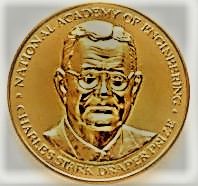Charles Stark Draper Prize

The U.S. National Academy of Engineering annually awards the Draper Prize,[1] which is given for the advancement of engineering and the education of the public about engineering. It is one of three prizes that constitute the "Nobel Prizes of Engineering"—the others are the Academy's Russ and Gordon Prizes. The Draper Prize is awarded biennially and the winner of each of these prizes receives $500,000.[2] The Draper prize is named for Charles Stark Draper, the "father of inertial navigation", an MIT professor and founder of Draper Laboratory.
Past winners
[edit]- 1989: Jack S. Kilby and Robert N. Noyce for their independent development of the monolithic integrated circuit
- 1991: Sir Frank Whittle and Hans von Ohain for their independent development of the turbojet engine
- 1993: John Backus for his development of FORTRAN, the first widely used, general purpose, high-level computer language[3]
- 1995: John R. Pierce and Harold A. Rosen for their development of communication satellite technology
- 1997: Vladimir Haensel for his invention of "platforming"
- 1999: Charles K. Kao, Robert D. Maurer, and John B. MacChesney for the development of fiber optics
- 2001: Vinton G. Cerf, Robert E. Kahn, Leonard Kleinrock, and Lawrence G. Roberts for the development of the Internet
- 2002: Robert Langer for the bioengineering of revolutionary medical drug delivery systems[4]
- 2003: Ivan A. Getting and Bradford W. Parkinson for their work developing the Global Positioning System
- 2004: Alan C. Kay, Butler W. Lampson, Robert W. Taylor, and Charles P. Thacker for their work on Alto, the first practical networked computer
- 2005: Minoru S. "Sam" Araki, Francis J. Madden, Edward A. Miller, James W. Plummer, and Don H. Schoessler for the design, development, and operation of Corona, the first space-based Earth observation systems
- 2006: Willard S. Boyle and George E. Smith for the invention of the charge-coupled device (CCD), a light-sensitive component at the heart of digital cameras and other widely used imaging technologies
- 2007: Tim Berners-Lee for developing the World Wide Web[5]
- 2008: Rudolf E. Kálmán for developing the Kalman filter[6]
- 2009: Robert H. Dennard for his invention and contributions to the development of dynamic random access memory (DRAM), used universally in computers and other data processing and communication systems[7]
- 2011: Frances H. Arnold and Willem P.C. Stemmer for their individual contributions to directed evolution, a process that allows researchers to guide the creation of certain properties in proteins and cells. This technique has been used in food ingredients, pharmaceuticals, toxicology, agricultural products, gene delivery systems, laundry aids, and biofuels
- 2012: George H. Heilmeier, Wolfgang Helfrich, Martin Schadt, and T. Peter Brody for their contributions to the development of liquid crystal display (LCD) technologies
- 2013: Thomas Haug, Martin Cooper, Yoshihisa Okumura (奥村 善久), Richard H. Frenkiel, and Joel S. Engel – mobile phone pioneers who laid the groundwork for cellular telephone networks (GSM) and today's smartphone.[8]
- 2014: John Goodenough, Yoshio Nishi (西 美緒), Rachid Yazami and Akira Yoshino (吉野 彰) – rechargeable battery pioneers who laid the groundwork for today's lithium-ion battery.
- 2015: Isamu Akasaki, M. George Craford, Russell Dupuis, Nick Holonyak, Jr. and Shuji Nakamura for the invention, development, and commercialization of materials and processes for light-emitting diodes (LEDs).[9][10]
- 2016: Andrew J. Viterbi for development of the Viterbi algorithm, its transformational impact on digital wireless communications, and its significant applications in speech recognition and synthesis and in bioinformatics.[11]
- 2018: Bjarne Stroustrup for conceptualizing and developing the C++ programming language.[12]
- 2020: Jean Fréchet and C. Grant Willson for the invention, development, and commercialization of chemically amplified materials for micro- and nanofabrication, enabling the extreme miniaturization of microelectronic devices.[13]
- 2022: Steve B. Furber, John L. Hennessy, David A. Patterson and Sophie M. Wilson for contributions to the invention, development, and implementation of reduced instruction set computer (RISC) chips.[14]
- 2024: Stuart Parkin for engineering spintronic technologies, enabling digital information storage that serves as a foundation for today’s data-driven world.[15]
The NAE website shows that no Draper Prize was awarded in 2010, 2017, 2019 or 2021.[16] Since the award is a biennial one, it was probably only given in even years beginning in 2016. The Russ Prize, also from the NAE, is awarded in odd years.
See also
[edit]References
[edit]- ^ Charles Stark Draper Prize – Home
- ^ Charles Stark Draper Prize – Awards
- ^ "John Backus". NAE Website. Retrieved 27 September 2018.
- ^ "Dr. Robert Langer". NAE Website. Retrieved 27 September 2018.
- ^ "Timothy J. Berners-Lee". NAE Website. Retrieved 27 September 2018.
- ^ "Rudolf Kalman". NAE Website. Retrieved 27 September 2018.
- ^ "Robert H. Dennard". NAE Website. Retrieved 27 September 2018.
- ^ 2015 Draper Prize – NAE Retrieved 2018-10-04.
- ^ 2015 Draper Prize Archived 2011-02-25 at the Wayback Machine Retrieved 2014-01-07.
- ^ 2015 Draper Prize – NAE Retrieved 2015-01-07.
- ^ 2016 Draper Prize – NAE
- ^ 2018 Draper Prize – NAE
- ^ 2020 Draper Prize – NAE
- ^ "Recipients of the Charles Stark Draper Prize for Engineering".
- ^ "Prof. Stuart Parkin awarded the prestigious Charles Stark Draper Prize for Engineering". www.mpi-halle.mpg.de. Retrieved 15 January 2024.
- ^ Previous Recipients
